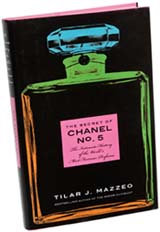|
Previews
|
|

|
The Monster Perfume
The story behind Chanel No. 5, the world's best selling perfume,
A book by Tilar Mazzeo '92
The Secret of Chanel No. 5: the Intimate History of the World's Most Famous Perfume
HarperCollins, 2010
See also In Their Own Words
by Anne Downey '95G
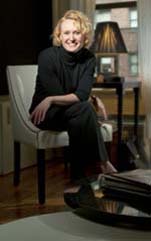
Photographer: Perry Smith
|
A successful perfume, as Tilar Mazzeo '92 defines it in her sensational new book about Chanel No. 5, The Secret of Chanel No. 5: the Intimate History of the World's Most Famous Perfume (HarperCollins, 2010), is an artful composition that "both captures a precise idea or feeling and is capable of evolving gracefully and beautifully in time as it slowly disappears from our perception." In 1919, Gabrielle "Coco" Chanel's idea was to create a scent that captured modernity by smelling both clean and sensual.
The story behind the world's best-selling perfume "is more fantastic than any fiction," writes Mazzeo. For example, the legend that Chanel obtained a long-lost manuscript detailing the formula for a perfume made for the Medici queens is true. It didn't, however, lead directly to the creation of Chanel No. 5. The real story involves a rare microclimate, a White Russian prince, a visionary perfumer and Chanel's own complicated personal history.
The daughter of an itinerant peddler, Chanel was sent to live at a convent orphanage at the age of 12 after her mother died of tuberculosis. That starkly beautiful setting was where she learned to appreciate purity and minimalism, and, in doing the laundry, the smell of cleanliness.
That scent never disappeared from her memory. Later, as a showgirl and a courtesan, she learned how a woman's fragrance "told a silent story about her sexuality": respectable women wore delicate, one-note floral scents, while the aromas of the demimondaines were derived from jasmine, musk, patchouli and tuberose.
Mazzeo also disproves the conventional wisdom that marketing is behind the extraordinary success of the perfume known in the industry as le monstre (the monster), a bottle of which is sold somewhere every 30 seconds. In fact, for its first 45 years, the perfume survived despite its marketing, which was largely uninspired. During World War II, it was mass marketed in military commissaries alongside chocolate bars and soap powder. The quality of the perfume remained the same, however, and Chanel No. 5 became a symbol—of life before the war, and the hope that that life could somehow survive.
Mazzeo teaches British romantic poetry and critical theory at Colby College. Her love affair with French culture began when she spent a gap year between high school and college backpacking across Europe. She came up with the idea for her book after she spent three months tasting and smelling wine every day while researching another book. "I wondered: what ingredients make a great perfume?"
Her research took her all over France—to Aubazine, the convent where Chanel spent her teenage years, to Grasse for the rose harvest, to the Chanel archives in Paris. "The biggest surprise for me in writing the book was how complex my relationship with Chanel became," she says. "So much of her life is admirable—she was a brilliant designer and entrepreneur. But there was also this other side to her that wasn't so admirable, and I had moments where I had trouble understanding her motivations and actions. She had nerves of steel, and was a much harder woman than I expected." ~
|
Overviews:

The Vaults
by Toby Ball, business manager, Crimes Against Children Research Center
St. Martin's Press, 2010
See at amazon.com
Ball's impressive first novel takes place during the 1930s and revolves around an archivist whose discovery reveals wide-ranging corruption and a wonderfully seedy cast of characters.
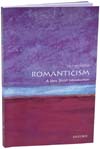
Romanticism: A Very Short Introduction
by Michael Ferber (professor of English)
Oxford University Press, 2010
See at amazon.com
This pocket-sized volume is big on ideas—that Romanticism was a revolution rather than a movement, for example—and provides general yet learned answers to the questions: What is Romanticism? Who are the Romantics? What do they have in common? Why do we call them Romantics?
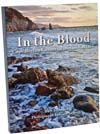
In the Blood: Cape Breton Conversations on Culture
by Burt Feintuch (director, Center for the Humanities), photos by Gary Samson
Utah State University Press, 2010
See at amazon.com
This lovely book contains a broad range of Cape Bretoners who talk about their unique group identity and world view.
|
   
In Their Own Words
Descriptions of new and recent written work by the authors themselves
Tim Gillespie '89
See at amazon.com
Doing Literary Criticism: Helping Students Engage with Challenging Texts
During my rookie year as a high school English teacher, I had a seemingly insignificant interaction with a student that nonetheless stuck with me. I'd been peppering a class with the kinds of questions I'd typically ask about a story we'd just read: "So, what did you folks make of that? What do you think the author was trying to say? What meaning did you find in this story?"
Roy raised his hand and said, "Mr. G., why don't you just tell us the answer and save everybody some time?"
That nettlesome question stayed under my skin for the nearly forty years I was a public school teacher. It became a touchstone for me, the question that would remind me again and again of the central purposes of my work. My job as a teacher of language, literature and writing was to help young readers and writers develop the moxie, skills and patience to find their own answers and meanings—and then to back them up with evidence and explain them clearly. The complex problems we face aren't going to be solved by people who sit around and wait for someone else to tell them what to think. Literacy means gaining the tools and dispositions to be an independent thinker and critical reader of words and the world.
My new book, Doing Literary Criticism, is an account of my attempts over almost four decades in my high school English classroom to cultivate such independent thinking. Steeped in stories of interactions with students, the book shares a baker's dozen of critical approaches and activities for young readers encountering challenging pieces of writing. It discusses ways to approach books from biographical, historical, psychological, archetypal, moral, philosophical, political, postmodern and other points of view. Though it's mainly aimed at fellow high school and community college English teachers with lots of specific classroom ideas, some members of a local book group out here where I live in Portland, Oregon, recently told me they found the book useful for suggesting angles of approach for their monthly book chats.
I'm just happy whenever any reader can say, as Roy did at the end of my rookie year, "Hey, Mr. G., I got some cool ideas to share about this story!"
My experience at UNH way back in 1989 has a connection to this project. After many years of teaching in Oregon, I had an opportunity to take a sabbatical to do graduate work. My wife and I rented out our house, packed up our two young sons, and headed across country for a year in New Hampshire. We chose UNH for a number of reasons, not the least of which was the opportunity to have a year in history-rich New England with our boys. But I was also drawn by the world-class community of writers and scholars doing pioneering work in the study of literacy at UNH. For that year in Durham, I had the wonderfully eye-opening opportunity to hang around the edges of a community of thinkers that included Donald Graves, Don Murray, Jane Hansen, Tom Newkirk and many others who have made incalculable contributions to our understanding of how to help students become better writers and readers. In that remarkable community, the voices and insights of working classroom teachers were sought and valued. So when my little family drove back across country in our Volkswagen van at the end of that year, I had not only my MA in English but also the conviction that I had a contribution to make as a teacher-writer. Thus I hold UNH partly responsible for this book!
Read more about the book and more about the author.
|

 |
|
Sarah Shea Smith '78, '89G
See at turkeypond.com
They Sawed Up a Storm: the Women's Sawmill at Turkey Pond, New Hampshire, 1942
It's hard to predict how a college education will come in handy until you are faced with a new challenge. When John Willey, sawmill manager in Andover, New Hampshire, plunked his mother's scrapbook in my lap back in 1999, I knew right away that the story of the women depicted in the tattered collection of photographs and newspaper clippings was something I had to pursue. It was a quest that required every one of my skills to uncover, to research, to make connections, to compile stories, and finally to write They Sawed Up a Storm: the Women's Sawmill at Turkey Pond, New Hampshire, 1942.
UNH gave me a solid foundation of technical skills (BS in forestry, '78) and an awareness of the educational process (Masters in occupational and adult education, '89). Combine that with extracurricular experiences like the Woodsman's Team( where I met my husband of 32 years)and milking cows at the Ritzman barn, I couldn't help but develop a sense of adventure.
After my first graduation from UNH in 1978, I spent eight years working in the forest industry and two years as a teacher. Following my second graduation in 1989, I have spent the last 21 years of my career at UNH Cooperative Extension as the forest industry specialist. The education and experience provided the perfect storm, or the crooked road depending how you look at it--for telling the story of the women's sawmill at Turkey Pond.
They Sawed Up a Storm is about an extraordinary group of women who operated a sawmill during World War II at Turkey Pond in Concord, NH. The sawmill, one of two on the pond, was built to saw what remained of logs still floating in the water from the 1938 hurricane. The book begins with the hurricane and its path of destruction from Long Island to northern New England. As a result, The Northeast Timber Salvage Administration (a federal, Roosevelt-Era program) was established to recover the felled timber. Four years later, when the U.S. had entered WWII, the salvage program was still operating and struggled to find laborers. In 1942, copying other wartime industries that recruited women, the U.S .Forest Service built a sawmill and hired women to run it. The October 26, 1942, Concord Daily Monitor headline read, "Women-Operated Sawmill, First Of Kind in Country, Will Start Work Soon At Turkey Pond." Interviews, family stories and historic photographs bring the women of Turkey Pond to life. For more information about the book go to www.turkeypond.com.
|


|
|
Arlene Quaratiello '08G
See at amazon.com
The College Student's Research Companion: Finding, Evaluating, and Citing the Sources You Need to Succeed
I had always wanted to write a book, and in the mid-1990s, I remembered that old adage, "Write what you know!" At the time, I was the Coordinator of Library Instruction at Emerson College and had found that there was no really "user-friendly" book for college students about how to do effective library research. So I wrote a book called The College Student's Research Companion which was published in 1997 by Neal-Schuman Publishers.
Due to the rapid pace of technological change that has characterized the past fifteen years, the recently-published fifth edition bears little resemblance to the first edition. But aside from advances in information technology, another change occurred within myself. I decided to switch careers from academic librarian to college English instructor. I entered the UNH Graduate School in 2006 and two years later received my master's degree in English Literature. During my final semester, I taught Freshman Composition as a teaching assistant. I am now an adjunct instructor at St. Anselm College, and these experiences with teaching have transformed my book from a simple guide to library resources into a more complex discussion of the research process.
My book also now has a subtitle: Finding, Evaluating, and Citing the Sources You Need to Succeed. My studies at UNH, and, in particular, the opportunity that the university gave me to teach an English class, have enabled me to give my book a broader appeal and make it the perfect textbook for any Freshman Composition class, covering not only how to find library resources, but also how to evaluate them and uphold academic honesty.
Since I have not actually worked in a library for a number of years, for this updated edition, I enlisted the help of collaborator Jane Devine, Chief Librarian at LaGuardia Community College and author of Going beyond Google, who advised me on the latest developments in information technology from a practicing librarian's viewpoint.
For more information about The College Student's Research Companion: Finding, Evaluating, and Citing the Resources You Need to Succeed see: www.neal-schuman.com.
|
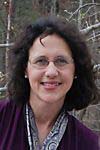
 |
Anne Downey '95G, a freelance writer who lives in Eliot, Maine, received her Ph.D. in English from UNH.
|























